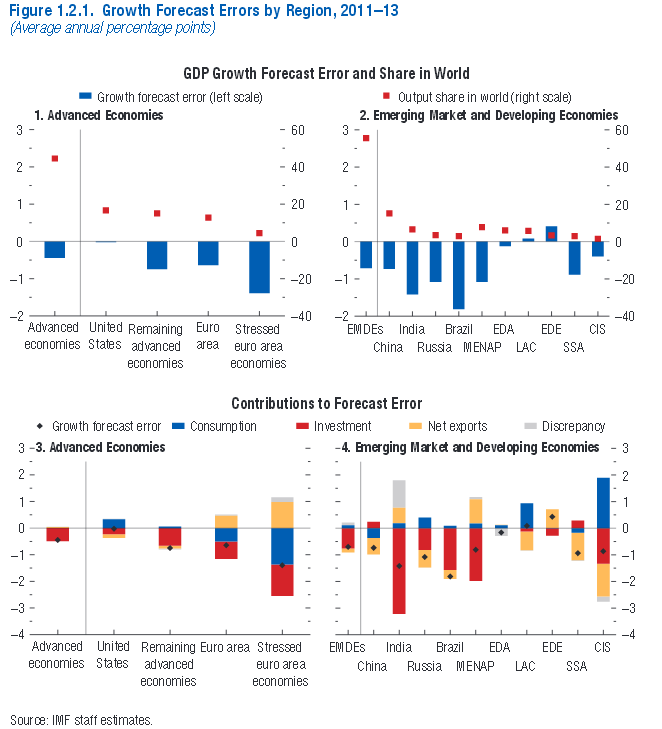The IMF’s latest World Economic Outlook (WEO) forecasts global growth to average 3.3 percent in 2014―unchanged from 2013―and to rise to 3.8 percent in 2015. The weaker than expected growth outlook for 2014 reflects setbacks to economic activity in the advanced economies during the first half of 2014, and a less optimistic outlook for several emerging market economies, says the report.
Here is the 44 page updated IMF world Economic Outlook
It included a five-page explanation of why it has kept overestimating the strength of the recovery.
Bad guesses on growth in the BRIC countries—Brazil, Russia, India, and China—accounted for about half the error, even though their share of the global economy is only about 28 percent, the IMF said. In addition, “Four stressed economies in the Middle East account for another 20 percent of the global forecast error,” it said. Those four are Egypt, Iran, Iraq, and Libya. In the case of the BRICs, the IMF said it has been gradually revising down not only the countries’ near-term growth, but their long-term growth potential.
From 2011 through 2014, the average miss on the year-ahead forecasts was 0.6 percentage point, the IMF said in its post mortem.
Emerging markets are adjusting to slower growth
Growth in emerging market and developing economies will continue to account for the lion’s share of global growth. Still, at 4.4 percent for 2014, the growth forecast is a bit weaker than in the April 2014 WEO. This slowdown is due to lackluster domestic demand and the impact of increasing geopolitical tensions, especially on Russia and neighboring countries.
• In China, growth is expected to decline slightly in 2014-15 to 7.4 percent, as the economy transitions to a more sustainable path. Growth is expected to remain strong elsewhere in emerging and developing Asia.
• In India, growth is expected to increase in the rest of 2014 and 2015, as exports and investment continue to pick up and more than offset the effect of an unfavorable monsoon on agricultural growth earlier in the year.
• In Latin America, the growth rate is forecast to decrease by half this year, to around 1.3 percent, due to declining exports as well as domestic constraints. Growth is expected to rebound to around 2.2 percent in 2015.
• In sub-Saharan Africa, stronger growth is expected because of supportive external demand conditions and strong investment demand, although prospects vary across countries.
• In the Middle East and North Africa, the recovery remains fragile even as growth is expected to start picking up modestly on the back of improving domestic security conditions and improving external demand. Similar considerations underpin modest improvements in activity in Russia and other economies of the Commonwealth of Independent States.
If you liked this article, please give it a quick review on ycombinator or StumbleUpon. Thanks

Brian Wang is a Futurist Thought Leader and a popular Science blogger with 1 million readers per month. His blog Nextbigfuture.com is ranked #1 Science News Blog. It covers many disruptive technology and trends including Space, Robotics, Artificial Intelligence, Medicine, Anti-aging Biotechnology, and Nanotechnology.
Known for identifying cutting edge technologies, he is currently a Co-Founder of a startup and fundraiser for high potential early-stage companies. He is the Head of Research for Allocations for deep technology investments and an Angel Investor at Space Angels.
A frequent speaker at corporations, he has been a TEDx speaker, a Singularity University speaker and guest at numerous interviews for radio and podcasts. He is open to public speaking and advising engagements.






